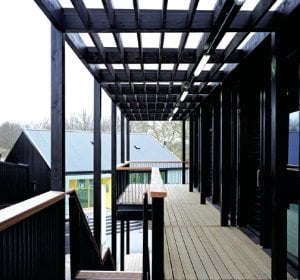Right here in the barn
Rural regeneration and artist development go hand-in-hand with imaginative fundraising at Wysing, says Donna Lynas.

On the evening of Friday 18 January this year, a ten-year process finally came to an end. Wysing Arts, a ramshackle collection of dilapidated farm buildings on the outskirts of Cambridge, converted and occupied by a group of artists, had at last been transformed into Wysing Arts Centre – a visual arts centre with stylish new buildings that reflect the centre’s commitment to contemporary visual art practice. Of course, the story is more than a simple physical makeover. The organisation outwardly and internally has changed beyond all recognition.
Twenty years ago Wysing Grange was yet another family farm that was no longer financially viable. The owners sold up, and that is when four enterprising friends moved in, aiming to convert its buildings in order to provide low-cost studio space for artists. It all started out as a bit of a ‘project’, but falling-down buildings, cracked concrete yards, and 11 acres of farmland to look after proved difficult to manage and maintain. However, they were in it for the long-run, and when the organisation became a registered charity in 1994 the founders employed their first professional member of staff – Director, Trystan Hawkins.
Four years later, Wysing was on a route that ensured that it had a future. The seed of the idea was a purpose-built studio building created for and in consultation with artists, which would replace some of the redundant farm buildings. It took a further six years, an Arts Council England (ACE) ‘health-check’ and a long consultation process, before ACE agreed to put £780,000 into the project. In the early days Wysing was funded by its original founders, whose private trust still owns the land that is leased long term to Wysing Arts Charity at a peppercorn rent. Two of the four founders continue to sit on its Board of non-executive Directors, and it is to their credit that they have gently and quietly supported growth and change, some of which has been significant.
Wysing has been something of a work in progress – staff and artists have come and gone and money has been tight. But throughout it all it was the physical change that needed to be made, because if that could be achieved then the ramshackle farm would become something else entirely. When I was recruited in 2005 as the new Director, I took the job on because the capital project was on the cards – although in the end much further off than I had anticipated. I was recruited from South London Gallery, where I had been Curator for six years, to bring Wysing into the contemporary art world nationally. When recruiting the post, I don’t think that anyone could have anticipated just how much change would be needed to drive through the capital project, develop the staff team and studio artists, and make the organisation artistically relevant beyond the Eastern region.
With the help of a fundraiser, brought in for three years to work specifically on the capital project, dozens of applications to trusts and foundations were made. In the end, aside from two major coups – successful applications to Garfield Weston and Foyle Foundations – it was those closer to home who came up with the cash: half a million came from EEDA, the regional development agency, and nearly £250,000 in private donations from local companies and individuals, plus many small donations from locally based trusts. The local authority, South Cambridgeshire District Council, contributed £225,000. As with all capital projects, it was the last £150,000 that was the hardest to bring in, and in the end we had to do some ‘value engineering’ to get a building we could afford.
Managing the expectations was extremely difficult, given that Wysing was also in the midst of change and aiming to build some artistic credibility. The charitable funding side of what had been the ‘old’ Wysing – a craft focus, lots of (undersubscribed) children’s workshops and a programme for adults with learning difficulties – were phased out. These were being replaced with projects by artists interested in collective ways of working who were exploring models of social and educational exchange and working contextually. Artists began to work directly with the communities that surrounded Wysing, including local Traveller families and villagers. At one point during the fundraising effort, I realised that a new model was needed and that working in partnership with ACE and with some of Cambridge’s businesses was going to be the way forward for us. Traditional fundraising tactics coupled with an emphasis on educational activity just didn’t work for Wysing. In some ways it is a relief not to work like that, and to be able to be honest about wanting to be artistically experimental, really to focus on the art and on building new audiences for it.
It is so easy to allow all those structures – self-imposed or funder-imposed – to get in the way of what an organisation is really for. Wysing really is, and always has been, a centre for artists and audiences wanting to push their practices in a supportive environment. The new buildings are hugely symbolic and really represent externally what has been happening to Wysing internally – a process of consolidation: of ideas, of ethos, and of artistic
vision.
Join the Discussion
You must be logged in to post a comment.